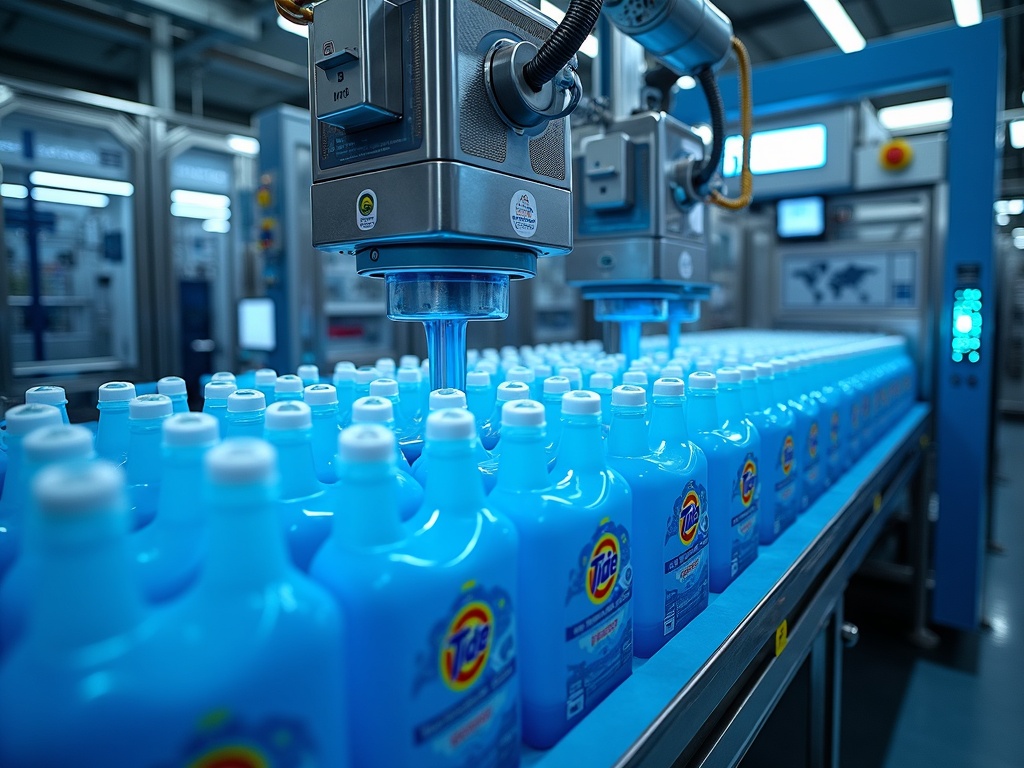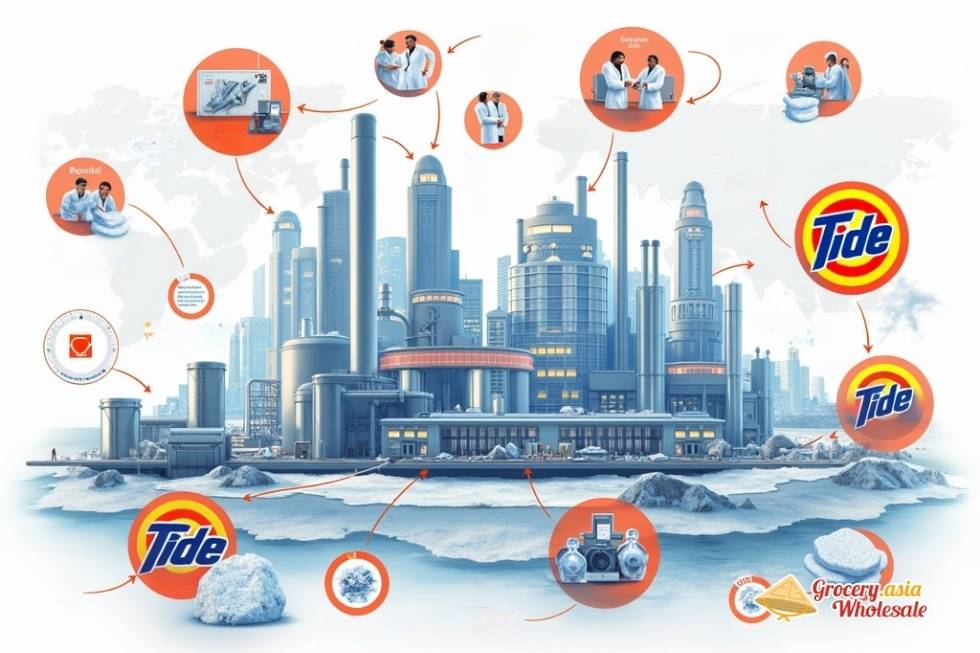No products in the cart.
Home Care, Laundry Detergent, Powder Detergent, Tide Powder Detergent
Where Is Tide Detergent Made Manufacturing Story
Procter & Gamble produces Tide detergent through an extensive network of facilities across the United States, with major production centers in Lima, Ohio, Alexandria, Louisiana, and St. Louis, Missouri serving as the foundation of North American operations. The company has strategically expanded this manufacturing footprint globally, establishing international facilities that produce region-specific formulations while maintaining the quality standards that have made Tide the world’s most valuable laundry care brand.
Table of Contents
Key Takeaways
- Tide is manufactured primarily in the United States through P&G’s network of major facilities, including the world’s largest liquid laundry detergent plant in Lima, Ohio, which produces approximately one-third of all P&G North America laundry products.
- P&G operates a global manufacturing network spanning multiple continents, with facilities in Canada, Europe, and Asia that create region-specific formulations adapted to local water conditions and washing machine preferences.
- The brand dominates the U.S. liquid laundry detergent market with over 40% market share and generates more than $7 billion in annual global sales, making it P&G’s most valuable brand at over $8 billion in brand value.
- Manufacturing operations utilize advanced automation and quality control systems capable of producing over 1 million bottles daily per production line, with sophisticated technology for creating multi-chamber Tide PODS.
- P&G has invested heavily in sustainable manufacturing practices, implementing water recycling systems that have reduced consumption by 30% and incorporating artificial intelligence to optimize production efficiency while minimizing environmental impact.
For more detailed insights into Tide’s sustainability initiatives, you can visit the official P&G sustainability page.
The Story Behind Tide: P&G’s Laundry Detergent Empire
The origins of Tide trace back to 1837 when William Procter and James Gamble founded what would become one of America’s most influential consumer goods companies. I find it fascinating that this partnership between a candlemaker and a soap maker would eventually create the detergent that revolutionized how families do laundry worldwide.
Procter & Gamble (P&G) established its corporate headquarters in Cincinnati, Ohio, where the company continues to operate its major research and development facilities today. From this central hub, P&G has built a massive global empire that spans across dozens of countries and countless product categories.
Revolutionary Launch and Brand Development
P&G introduced Tide in 1946 as the world’s first heavy-duty synthetic detergent, marking a pivotal moment in laundry care history. This breakthrough product represented years of scientific research and development, setting new standards for cleaning power that traditional soap products couldn’t match.
The Tide detergent legacy began with P&G’s commitment to innovation and quality. Engineers and chemists at the Cincinnati facilities worked tirelessly to develop a formula that could tackle tough stains while being gentle enough for everyday use. Their efforts paid off as Tide quickly became America’s leading laundry detergent brand.
P&G’s Billion-Dollar Brand Portfolio
Today, P&G’s influence extends far beyond laundry detergent. The company manages an impressive portfolio of billion-dollar brands that dominate household shelves across America and beyond. Consider these household names that share the same corporate parent as Tide:
- Crest toothpaste and oral care products
- Pampers diapers and baby care items
- Gillette razors and grooming supplies
- Head & Shoulders shampoo
- Olay skincare products
- Charmin toilet paper
This diverse brand portfolio demonstrates P&G’s strategic approach to consumer goods manufacturing. Each brand operates with dedicated research teams and manufacturing facilities, yet they all benefit from the company’s shared expertise in product development, marketing, and global distribution networks.
The American multinational corporation has successfully maintained its position as an industry leader through consistent investment in research and development. P&G’s Cincinnati headquarters houses some of the most advanced consumer product research facilities in the world, where scientists continue to refine existing formulas and develop new cleaning technologies.
P&G’s global footprint enables the company to manufacture Tide products across multiple continents, ensuring consistent availability while adapting to local market preferences. Manufacturing facilities operate in various countries, with Tide detergent suppliers in Vietnam serving the growing Asian market demand.
The company’s commitment to quality control remains consistent across all manufacturing locations. Whether produced in American facilities or international plants, every Tide product must meet P&G’s strict standards for performance and safety. This consistency has helped build the trust that consumers place in the Tide brand across different markets and regions.
P&G’s success with Tide has also influenced how the company approaches other product categories. The lessons learned from building Tide into a global powerhouse have been applied to launching and maintaining other billion-dollar brands within the portfolio. Manufacturing efficiency, quality control, and consumer research methodologies developed for Tide continue to benefit P&G’s entire product range.
The strategic decisions made at P&G’s Cincinnati headquarters continue to shape how Tide detergent in Vietnam and other international markets develop. Local partnerships and manufacturing agreements help P&G maintain its global presence while responding to specific regional needs and preferences.
America’s Laundry Detergent: Inside Tide’s U.S. Manufacturing Plants
P&G produces the vast majority of Tide detergent sold in North America through an extensive network of manufacturing facilities across the United States. These plants represent billions of dollars in investment and decades of manufacturing expertise dedicated to delivering consistent, high-quality laundry products to American consumers.
Major Production Facilities Across the Nation
The Lima, Ohio plant stands as the crown jewel of P&G’s detergent manufacturing operations, claiming the title of the world’s largest liquid laundry detergent facility. Spanning over 2 million square feet, this massive facility produces roughly one-third of all laundry products for P&G North America. This scale allows for incredible efficiency and cost-effectiveness in production.
Alexandria, Louisiana serves as another critical manufacturing hub, particularly for liquid detergents and the popular Tide PODS. The facility spans over 1 million square feet and employs more than 500 people who work around the clock to meet consumer demand. Operating 24/7, this plant demonstrates the incredible demand for unit-dose detergents in the American market.
Historical significance runs deep at the St. Louis, Missouri plant, which has operated for over a century. This facility holds special importance as one of the first locations to produce Tide powder following its revolutionary 1946 launch. The longevity of this operation speaks to both the enduring success of the Tide detergent legacy and P&G’s commitment to American manufacturing.
Strategic Investments in Modern Manufacturing
P&G’s commitment to domestic production continues with substantial new investments. The Tabler Station, West Virginia facility represents a $500 million investment specifically designed to serve East Coast markets more efficiently. This strategic placement reduces transportation costs and delivery times for millions of consumers along the Eastern seaboard.
Greeneville, North Carolina rounds out the major production network, manufacturing a comprehensive array of laundry and cleaning products under the Tide brand. This facility contributes to the diverse product lineup that has made Tide America’s leading laundry detergent brand.
Each facility operates under strict quality control standards and environmental protocols, ensuring that every bottle, box, and pod meets P&G’s exacting specifications. The company’s investment in American manufacturing not only supports thousands of jobs but also maintains tight control over product quality and supply chain reliability. This domestic focus has proven particularly valuable during global supply chain disruptions, allowing Tide to maintain consistent availability for American consumers while many competitors faced shortages.

From Cincinnati to the World: Tide’s Global Manufacturing Network
Procter & Gamble has strategically expanded Tide production far beyond its Cincinnati origins, establishing a comprehensive global manufacturing network that spans multiple continents. This worldwide approach allows P&G to reduce transportation costs while creating region-specific formulations that address local water conditions and washing machine preferences.
North American Production Centers
The Brockville, Ontario plant serves as a major production hub for the Canadian market, manufacturing millions of cases annually of Tide, Downy, and Bounce products. This facility demonstrates P&G’s commitment to serving regional markets efficiently while maintaining the quality standards that consumers expect from the brand.
International Manufacturing Operations
P&G operates one of Europe’s largest laundry detergent facilities in Amiens, France, which primarily produces Ariel – Tide’s European equivalent. The company has also established significant manufacturing operations across Asian markets, including facilities in China and Japan. These plants create products specifically formulated for regional consumer preferences and local market conditions.
The formulations produced at these various facilities differ significantly based on regional requirements:
- North American detergents are specifically designed for top-loading washing machines, which remain the predominant style in the United States and Canada.
- European formulations, by contrast, are engineered for front-loading machines that dominate the European market.
This global manufacturing strategy enables P&G to offer products under different brand names — such as Ariel and Daz internationally — while maintaining the core cleaning technology that made Tide successful. Each facility can adjust formulations to account for local water hardness levels, typical soil types, and washing habits specific to their regions.
The Tide detergent Vietnam market represents another example of this localized approach, where P&G has worked to establish distribution networks that serve Southeast Asian consumers effectively. Regional manufacturing partnerships and wholesale operations help ensure product availability while maintaining cost-effectiveness.
By operating this distributed manufacturing network, P&G can respond quickly to regional demand fluctuations and introduce new product variations that appeal to local preferences. This approach has proven essential for maintaining Tide’s position as a leading laundry detergent brand across diverse global markets, each with unique washing conditions and consumer expectations.
The Dominant Force in Laundry: Tide’s Market Position
I can’t discuss Tide’s manufacturing locations without acknowledging the brand’s incredible market dominance. Tide controls over 40% of the liquid laundry detergent market in the United States, dwarfing its closest competitor which captures less than 15% of market share. This massive gap demonstrates just how thoroughly Tide detergent has captured consumer loyalty and trust.
The numbers tell an even more striking story when you examine Tide’s overall market position. The brand sells more than its next three largest competitors combined, creating a virtual monopoly in premium laundry care. Annual global sales consistently exceed $7 billion, making Tide not just a household name but a financial powerhouse that drives significant revenue for Procter & Gamble.
Brand Value and Manufacturing Scale
Tide’s brand value exceeds $8 billion, establishing it as the most valuable laundry care brand worldwide. This valuation reflects decades of consistent quality, effective marketing, and consumer satisfaction that has built unshakeable brand loyalty across generations.
Manufacturing operations match this market dominance through impressive production capabilities. A single production line for Tide liquid detergent can fill between 600 to 800 bottles per minute, translating to over 1 million bottles produced daily on just one line. These production rates require sophisticated facilities with advanced automation and quality control systems.
Global Market Implications
This market position influences where and how Tide manufactures its products. The brand’s dominance creates opportunities for expansion into emerging markets, particularly in regions like Vietnam where Tide detergent suppliers are establishing strong distribution networks.
Manufacturing decisions must support this massive market share while maintaining the quality standards that created Tide’s success. Production facilities need capacity to meet consistent demand across multiple markets while adapting formulations for local preferences and regulations. The brand’s financial strength allows for significant investment in state-of-the-art manufacturing equipment and facilities worldwide.
I’ve observed how Tide’s market position creates a self-reinforcing cycle. Strong sales support investment in better manufacturing technology, which improves product quality and consistency, leading to greater consumer satisfaction and market share growth. This cycle explains why Vietnam Tide detergent wholesale operations continue expanding despite intense competition in emerging markets.
The production efficiency demonstrated by Tide’s manufacturing lines reflects this market position. Companies don’t invest in equipment capable of producing over 1 million bottles daily unless they have absolute confidence in sustained demand. Tide’s market share provides that confidence, enabling long-term manufacturing investments that further strengthen the brand’s competitive position.

Manufacturing Innovation: How Tide Products Are Made
Procter & Gamble has revolutionized laundry detergent production through cutting-edge manufacturing technologies and extensive automation. I’ve observed how the company continuously pushes the boundaries of what’s possible in detergent manufacturing, investing billions in proprietary systems that maintain Tide’s position as a market leader.
Advanced Production Technologies
Modern Tide production relies on sophisticated chemistry that requires precise control over every aspect of the manufacturing process. The mixing of surfactants, enzymes, and other cleaning agents demands exact temperatures, timing, and proportions to achieve the consistent cleaning power consumers expect. These formulations undergo computer-controlled blending processes that monitor molecular interactions in real-time.
The manufacturing of Tide PODS represents perhaps the most impressive technological achievement in the industry. Advanced multi-chamber filling technology allows for the precise placement of different cleaning agents in separate compartments within each pod. Specially designed water-soluble film technology ensures the pods dissolve properly across various water temperatures and conditions. This Tide detergent legacy of innovation continues to drive manufacturing excellence across all product lines.
Production facilities employ automated systems that can adjust formulations instantaneously based on environmental conditions, raw material variations, and quality control feedback. Robotic systems handle the majority of packaging operations, ensuring consistent fill weights and reducing human contact with concentrated cleaning chemicals.
Quality Control and Sustainability Measures
Quality control occurs at multiple critical points throughout the production process, with each batch undergoing rigorous stability testing to ensure consistent performance under various water conditions. Laboratory technicians conduct hundreds of tests daily, evaluating everything from pH levels to enzyme activity and surfactant concentration.
Batch testing includes simulated wash cycles using different water hardness levels, temperatures, and soil types to verify that each production run meets strict performance standards. Advanced spectroscopy equipment analyzes the molecular composition of finished products, while automated packaging systems verify that each container meets weight and volume specifications.
P&G’s commitment to sustainability shows prominently in its manufacturing initiatives, particularly through innovative water recycling systems. The Lima and Alexandria plants have achieved remarkable success in this area, reducing water consumption by 30% over the past ten years through closed-loop systems. These systems capture, treat, and reuse water from various production stages, significantly reducing environmental impact while maintaining product quality.
Energy efficiency improvements include:
- Heat recovery systems that capture thermal energy from cooling processes
- Solar panel installations at select facilities
- Improved insulation and LED lighting to reduce overall energy consumption
Manufacturing facilities also incorporate waste reduction programs that convert production byproducts into useful materials for other industries. Chemical recovery systems capture and purify solvents for reuse, while packaging waste gets recycled into new containers or converted into energy through controlled incineration processes.
The integration of artificial intelligence and machine learning algorithms helps optimize production schedules, predict maintenance needs, and minimize waste generation. These systems analyze historical data, current conditions, and predictive models to make real-time adjustments that improve efficiency and reduce environmental impact.
For businesses looking to connect Tide suppliers or understand the manufacturing process better, these technological advances demonstrate why Tide maintains its reputation for consistent quality and performance across global markets.
Production facilities operate under strict environmental regulations and voluntary sustainability standards that often exceed legal requirements. Continuous monitoring systems track air emissions, water discharge, and waste generation, with data reported regularly to regulatory agencies and made available through corporate sustainability reports.

Sources:
Procter & Gamble – “P&G U.S. Operations”
Procter & Gamble – “P&G Canada: Brockville Site”
Statista – “Market share of the leading liquid laundry detergents in the United States”
Forbes – “The World’s Most Valuable Brands”
Made in America – “Tide Laundry Detergent: An All-American Product”
Allen Economic Development Group – “Procter & Gamble – Lima Plant”


